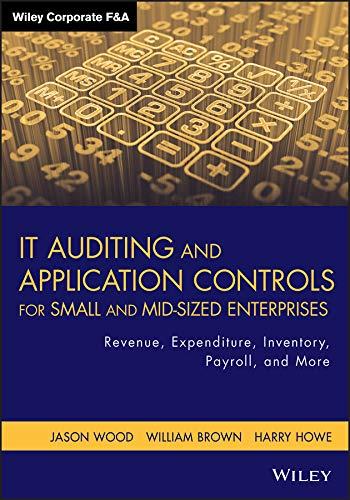Question
Pea Corporation acquired 80 percent of Split Brewing Companys stock on January 1, 20X1, at underlying book value. At that date, the fair value of
Pea Corporation acquired 80 percent of Split Brewing Companys stock on January 1, 20X1, at underlying book value. At that date, the fair value of the noncontrolling interest was equal to 20 percent of Splits book value. On January 1, 20X1, Split issued $300,000 par value, 8 percent, 10-year bonds to Malt Company for $360,000. Pea subsequently purchased $100,000 of the bonds from Malt for $102,000 on January 1, 20X3. Interest is paid semiannually on January 1 and July 1. Summarized balance sheets for Pea and Split as of December 31, 20X4, follow:
| PEA CORPORATION | |||||||
| Balance Sheet | |||||||
| December 31, 20X4 | |||||||
| Cash & Receivables | $ | 122,500 | Accounts Payable | $ | 40,000 | ||
| Inventory | 200,000 | Bonds Payable | 400,000 | ||||
| Buildings & Equipment (net) | 320,000 | Common Stock | 200,000 | ||||
| Investment in Split Company: | Retained Earnings | 309,627 | |||||
| Bonds | 101,607 | ||||||
| Stock | 205,520 | ||||||
| Total Assets | $ | 949,627 | Total Liabilities & Owners Equity | $ | 949,627 | ||
| SPLIT BREWING COMPANY | |||||||
| Balance Sheet | |||||||
| December 31, 20X4 | |||||||
| Cash & Receivables | $ | 124,000 | Accounts Payable | $ | 28,000 | ||
| Inventory | 150,000 | Bonds Payable | 300,000 | ||||
| Buildings & Equipment (net) | 360,000 | Bond Premium | 39,739 | ||||
| Common Stock | 100,000 | ||||||
| Retained Earnings | 166,261 | ||||||
| Total Assets | $ | 634,000 | Total Liabilities & Owners Equity | $ | 634,000 | ||
At December 31, 20X4, Split holds $42,000 of inventory purchased from Pea, and Pea holds $26,000 of inventory purchased from Split. Split and Pea sell inventory to each other at cost plus markups of 30 percent and 40 percent, respectively. Assume total sales from Pea to Split were $100,000 and from Split to Pea were $50,000. Required: a. Prepare all consolidation entries needed on December 31, 20X4, to complete a consolidated balance sheet worksheet. Assume Split earned $74,476 and paid $10,000 in dividends during the year. (If no entry is required for a transaction/event, select "No journal entry required" in the first account field. Do not round your intermediate calculations. Round your final answers to nearest whole dollar.)





 Consolidation Worksheet Entries Record the basic consolidation entry. Note: Enter debits before credits. Consolidation Worksheet Entries Record the entry to defer the unrealized profits on inventory transfers. Note: Enter debits before credits. Consolidation Worksheet Entries Record the bonds and other debt consolidation entries. Note: Enter debits before credits. Consolidation Worksheet Entries Record the entry to eliminate the intercompany interest receivables/payables. Note: Enter debits before credits. b. Prepare a consolidated balance sheet worksheet. (Values in the first two columns (the "parent" and "subsidiary" balances) that are to be deducted should be indicated with a minus sign, while all values in the "Consolidation Entries" columns should be entered as positive values. For accounts where multiple adjusting entries are required, combine all debit entries into one amount and enter this amount in the debit column of the worksheet. Similarly, combine all credit entries into one amount and enter this amount in the credit column of the worksheet.) c. Prepare a consolidated balance sheet in good form. (Do not round your intermediate calculations. Round your final answers to nearest whole dollar.)
Consolidation Worksheet Entries Record the basic consolidation entry. Note: Enter debits before credits. Consolidation Worksheet Entries Record the entry to defer the unrealized profits on inventory transfers. Note: Enter debits before credits. Consolidation Worksheet Entries Record the bonds and other debt consolidation entries. Note: Enter debits before credits. Consolidation Worksheet Entries Record the entry to eliminate the intercompany interest receivables/payables. Note: Enter debits before credits. b. Prepare a consolidated balance sheet worksheet. (Values in the first two columns (the "parent" and "subsidiary" balances) that are to be deducted should be indicated with a minus sign, while all values in the "Consolidation Entries" columns should be entered as positive values. For accounts where multiple adjusting entries are required, combine all debit entries into one amount and enter this amount in the debit column of the worksheet. Similarly, combine all credit entries into one amount and enter this amount in the credit column of the worksheet.) c. Prepare a consolidated balance sheet in good form. (Do not round your intermediate calculations. Round your final answers to nearest whole dollar.) Step by Step Solution
There are 3 Steps involved in it
Step: 1

Get Instant Access to Expert-Tailored Solutions
See step-by-step solutions with expert insights and AI powered tools for academic success
Step: 2

Step: 3

Ace Your Homework with AI
Get the answers you need in no time with our AI-driven, step-by-step assistance
Get Started


